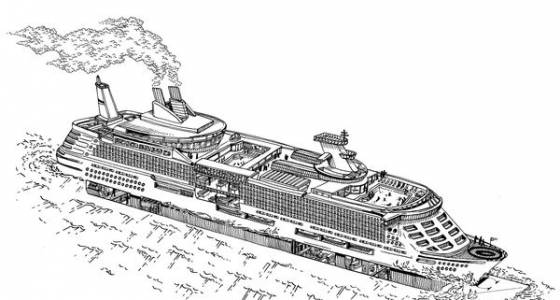Illustration by Lucy Engelman
Port of sprawl.
Cruise ships are entire cities set to sea—the largest ones can carry thousands of people. To function far from shore, floating burgs like these rely on washing machines that swallow hundreds of pounds of sheets, water-filtration systems that serve both fresh- and saltwater swimming pools, and an army of aerobic bacteria to eat tanks of poop. This is the often-hidden machinery working behind the scenes on an average mega-liner.
Illustration by Lucy Engelman
Just like in a small city, cruise ships have on-site waste recycling plants packed with trash-eating appliances.
In the waste-recycling plant, a 50-cubic-foot glass crusher gnashes bottles into pea-size pellets, hydraulics squeeze cardboard and aluminum into blocks, and incinerators burn nonrecyclable refuse. Some ships pulp food waste and tip it overboard as instant fish food.
Illustration by Lucy Engelman
Mega liners can have more than 20 pools onboard, all of which are filled with filtered ocean water.
To clean seawater, ships often rely on two main methods. Reverse-osmosis membranes filter out salt, and evaporators use heat from the engine to boil off the fresh H2O. Once liquid goes through one of these processes, it can safely fill onboard swimming pools.
Illustration by Lucy Engelman
In the funnel, steam and particulates are showered with a solution that traps sulfur oxides.
Exhaust scrubbers are the most innovative machinery on ships today. Before venting, exhaust enters a cylindrical tank. A solution of caustic soda or seawater sprays from all angles to trap toxic sulfur oxides. Then, the solution falls 150 feet into a storage tank.
Illustration by Lucy Engelman
The food crew ferries meal ingredients from ballroom-sized refrigerators and freezers.
A single ship can go through 23,000 pounds of flour and 42,000 pineapples (mostly for fruity cocktails) in a year. Ballroom-size freezers store ingredients until mealtime, when waiters deliver grub to 1,000-seat dining rooms via escalators.
Illustration by Lucy Engelman
Forget the “poop deck”—that’s just a nickname for the top deck. The real feces magic happens in onboard sewage farms.
Vacuum suction lines zip toilets’ contents to marine sanitation farms, which siphon out the water, treat it until it’s drinkable, then pump it into the ocean. Helpful aerobic bacteria digest the remaining sludge in storage tanks until it’s all offloaded ashore, about once a month.
Illustration by Lucy Engelman
Down in the bowels of a megaliner, large-capacity washing machines—which can hold up to 200 pounds of fabric—churn away to keep the clean towels coming.
Large-capacity washing machines—which can hold hundreds of pounds of fabric—churn away while elaborate machines iron and press. There’s even a 27-foot-wide device solely for stretching and folding sheets into crisp rectangles.
Illustration by Lucy Engelman
Many big liners have redundant systems—engine rooms, air conditioning compressor rooms, and diesel power generators—at both the aft and the stern.
Two floors below the “hotel,” or passenger decks, sit the engines, air-conditioning compressors, and diesel-power generators, which engineers can adjust directly or remotely, from a control room. Certain ships display these controls on massive touchscreen tables.
Illustration by Lucy Engelman
Included: snow rooms for bathing in the Nordic tradition.
More entertaining machines hustle on the upper decks. Cold compressed air and tiny water nozzles can fill spa rooms with snow. Some ships also have wave machines for onboard surfing or 23-foot-tall chambers that blast 100-mile-per-hour winds to simulate a skydive.
This article was originally published in the May/June 2017 issue of Popular Science, under the title “Port of sprawl.”
Our editors found this article on this site using Google and regenerated it for our readers.












